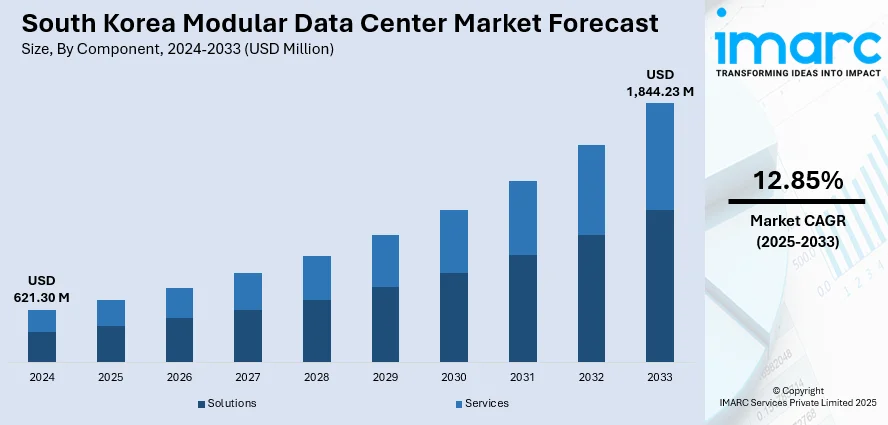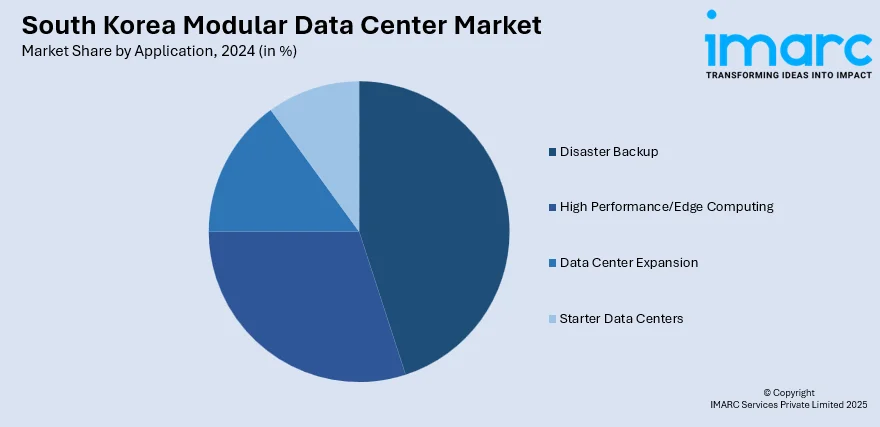
South Korea Modular Data Center Market Size, Share, Trends and Forecast by Component, Data Center Size, Application, Industry Vertical, and Region, 2025-2033
South Korea Modular Data Center Market Overview:
The South Korea modular data center market size reached USD 621.30 Million in 2024. Looking forward, IMARC Group expects the market to reach USD 1,844.23 Million by 2033, exhibiting a growth rate (CAGR) of 12.85% during 2025-2033. The market is primarily driven by the escalating demand for cloud services, the widespread integration of 5G technology, and the burgeoning need for efficient edge computing solutions. Government initiatives promoting digital transformation and decentralization further propel the South Korea modular data center market share.
|
Report Attribute
|
Key Statistics
|
|---|---|
|
Base Year
|
2024
|
|
Forecast Years
|
2025-2033
|
|
Historical Years
|
2019-2024
|
| Market Size in 2024 | USD 621.30 Million |
| Market Forecast in 2033 | USD 1,844.23 Million |
| Market Growth Rate 2025-2033 | 12.85% |
South Korea Modular Data Center Market Trends:
Decentralization and Edge Computing Adoption
The South Korean government is actively promoting the decentralization of data centers from congested metropolitan areas like Seoul to regional locations. For instance, in July 2025, South Korea invested KRW27.3 billion ($19.9M) to build regional micro data centers using domestic AI chips, aiming to deliver low-latency AI services to SMEs, hospitals, and public institutions. This strategic shift aims to address power supply challenges and foster balanced regional development. Concurrently, the proliferation of IoT devices, autonomous vehicles, and smart city initiatives is driving a significant demand for edge computing, which requires data processing closer to the source to minimize latency. Modular data centers are ideally suited for these decentralized and edge deployments due to their rapid deployability, scalability, and ability to operate efficiently in diverse environments, thereby contributing substantially to the South Korea modular data center market growth.

To get more information on this market, Request Sample
Integration with AI and High-Performance Computing
The rapid advancements in Artificial Intelligence (AI) and the increasing demand for high-performance computing (HPC) capabilities are profoundly impacting the South Korea Modular Data Center market. AI and big data analytics workloads require immense processing power and low-latency infrastructure, which traditional data centers may struggle to provide efficiently. Modular data centers, designed for high-density rack configurations and capable of supporting advanced cooling systems, are becoming the preferred choice for deploying AI-optimized infrastructure. This integration of cutting-edge technologies and the need for specialized computing environments are key contributors to the South Korea modular data center market growth. For instance, Alibaba Cloud is set to launch its second data centre in South Korea by June 2025 to meet rising demand for AI infrastructure. This expansion supports local industries including e-commerce, gaming, and logistics. The Seoul-based facility will offer low-latency AI services and provide an alternative to US providers like AWS.
South Korea Modular Data Center Market Segmentation:
IMARC Group provides an analysis of the key trends in each segment of the market, along with forecasts at the country/regional level for 2025-2033. Our report has categorized the market based on component, data center size, application, and industry vertical.
Component Insights:
- Solutions
- All-in-One Module
- Individual Module
- Services
- Design and Consulting
- Integration and Deployment
- Support and Maintenance
The report has provided a detailed breakup and analysis of the market based on the component. This includes solutions (all-in-one module and individual module) and services (design and consulting, integration and deployment, and support and maintenance).
Data Center Size Insights:
- Small and Medium-sized Data Centers
- Large Data Centers
The report has provided a detailed breakup and analysis of the market based on the data center size. This includes small and medium-sized data centers and large data centers.
Application Insights:

- Disaster Backup
- High Performance/Edge Computing
- Data Center Expansion
- Starter Data Centers
The report has provided a detailed breakup and analysis of the market based on the application. This includes disaster backup, high performance/edge computing, data center expansion, and starter data centers.
Industry Vertical Insights:
- BFSI
- IT and Telecom
- Retail and Manufacturing
- Healthcare
- Energy
- Media and Entertainment
- Government and Defense
- Others
The report has provided a detailed breakup and analysis of the market based on the industry vertical. This includes BFSI, IT and telecom, retail and manufacturing, healthcare, energy, media and entertainment, government and defense, and others.
Regional Insights:
- Seoul Capital Area
- Yeongnam (Southeastern Region)
- Honam (Southwestern Region)
- Hoseo (Central Region)
- Others
The report has also provided a comprehensive analysis of all the major regional markets, which include Seoul Capital Area, Yeongnam (Southeastern Region), Honam (Southwestern Region), Hoseo (Central Region), and others.
Competitive Landscape:
The market research report has also provided a comprehensive analysis of the competitive landscape. Competitive analysis such as market structure, key player positioning, top winning strategies, competitive dashboard, and company evaluation quadrant has been covered in the report. Also, detailed profiles of all major companies have been provided.
South Korea Modular Data Center Market News:
- In July 2025, FuelCell Energy and Inuverse signed an MOU to deploy up to 100MW of modular, fuel cell-based power for Korea’s upcoming AI Daegu Data Center by 2027. The partnership aims to improve energy efficiency and cooling through integrated thermal systems, supporting AI workloads while aligning with ESG goals. The clean, scalable energy platform allows phased deployment and reduces emissions, marking a key move in sustainable hyperscale data center development. This project strengthens FuelCell Energy’s presence in Korea and showcases its role in AI infrastructure expansion.
- In March 2025, SK Telecom partnered with Elice, Schneider Electric, and Giga Computing to accelerate the development of modular AI data centers in South Korea. The collaboration with Elice focuses on deploying containerized, portable modular data centers, while Schneider will assist in MEP systems for hyperscale builds. Giga Computing and SK Enmove will co-develop next-gen liquid cooling technologies. These efforts aim to enable rapid, scalable, and energy-efficient AI infrastructure to meet rising demand.
South Korea Modular Data Center Market Report Coverage:
| Report Features | Details |
|---|---|
| Base Year of the Analysis | 2024 |
| Historical Period | 2019-2024 |
| Forecast Period | 2025-2033 |
| Units | Million USD |
| Scope of the Report |
Exploration of Historical Trends and Market Outlook, Industry Catalysts and Challenges, Segment-Wise Historical and Future Market Assessment:
|
| Components Covered |
|
| Data Center Sizes Covered | Small and Medium-Sized Data Centers, Large Data Centers |
| Applications Covered | Disaster Backup, High Performance/Edge Computing, Data Center Expansion, Starter Data Centers |
| Industry Verticals Covered | BFSI, IT and Telecom, Retail and Manufacturing, Healthcare, Energy, Media and Entertainment, Government and Defense, Others |
| Regions Covered | Seoul Capital Area, Yeongnam (Southeastern Region), Honam (Southwestern Region), Hoseo (Central Region), Others |
| Customization Scope | 10% Free Customization |
| Post-Sale Analyst Support | 10-12 Weeks |
| Delivery Format | PDF and Excel through Email (We can also provide the editable version of the report in PPT/Word format on special request) |
Key Questions Answered in This Report:
- How has the South Korea modular data center market performed so far and how will it perform in the coming years?
- What is the breakup of the South Korea modular data center market on the basis of component?
- What is the breakup of the South Korea modular data center market on the basis of data center size?
- What is the breakup of the South Korea modular data center market on the basis of application?
- What is the breakup of the South Korea modular data center market on the basis of industry vertical?
- What is the breakup of the South Korea modular data center market on the basis of region?
- What are the various stages in the value chain of the South Korea modular data center market?
- What are the key driving factors and challenges in the South Korea modular data center market?
- What is the structure of the South Korea modular data center market and who are the key players?
- What is the degree of competition in the South Korea modular data center market?
Key Benefits for Stakeholders:
- IMARC’s industry report offers a comprehensive quantitative analysis of various Korea market segments, historical and current market trends, market forecasts, and dynamics of the South Korea modular data center market from 2019-2033.
- The research report provides the latest information on the market drivers, challenges, and opportunities in the South Korea modular data center market.
- Porter's five forces analysis assist stakeholders in assessing the impact of new entrants, competitive rivalry, supplier power, buyer power, and the threat of substitution. It helps stakeholders to analyze the level of competition within the South Korea modular data center industry and its attractiveness.
- Competitive landscape allows stakeholders to understand their competitive environment and provides an insight into the current positions of key players in the market.
Need more help?
- Speak to our experienced analysts for insights on the current market scenarios.
- Include additional segments and countries to customize the report as per your requirement.
- Gain an unparalleled competitive advantage in your domain by understanding how to utilize the report and positively impacting your operations and revenue.
- For further assistance, please connect with our analysts.
 Request Customization
Request Customization
 Speak to an Analyst
Speak to an Analyst
 Request Brochure
Request Brochure
 Inquire Before Buying
Inquire Before Buying




.webp)




.webp)












